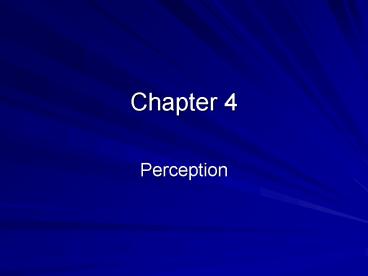Perception - PowerPoint PPT Presentation
1 / 27
Title:
Perception
Description:
Informational Medium the medium through which we perceive the distal object ... categories form the categorical prototype and are used to categorize new objects ... – PowerPoint PPT presentation
Number of Views:61
Avg rating:3.0/5.0
Title: Perception
1
Chapter 4
- Perception
2
Percept
- . . . a mental representation of a stimulus that
is perceived
3
James Gibson (1966)
- Distal Object an object in the external world
4
James Gibson (1966)
- Distal Object an object in the external world
- Informational Medium the medium through which
we perceive the distal object
5
James Gibson (1966)
- Distal Object an object in the external world
- Informational Medium the medium through which
we perceive the distal object - Proximal Stimulation stimulation of our sense
organ perceiving the distal object
6
James Gibson (1966, 1979)
- Distal Object an object in the external world
- Informational Medium the medium through which
we perceive the distal object - Proximal Stimulation stimulation of our sense
organ perceiving the distal object - Perceptual Object perception of the distal
object into a meaningful whole
7
Perceptual Constancies
- Size Constancy objects maintain their size no
matter how close or far they are
8
Perceptual Constancies
- Size Constancy objects maintain their size no
matter how close or far they are - Shape Constancy objects maintain their shapes
no matter what their orientation
9
Depth Perception
- Monocular Depth Cues factors such as grain,
size, and parallax
10
Depth Perception
- Monocular Depth Cues factors such as grain,
size, and parallax - Binocular Depth Cues factors such as eye
convergence and disparity
11
Gestalt Approaches to Form Perception
- Figure-Ground
12
Gestalt Approaches to Form Perception
- Figure-Ground
- Proximity
13
Gestalt Approaches to Form Perception
- Figure-Ground
- Proximity
- Similarity
14
Gestalt Approaches to Form Perception
- Figure-Ground
- Proximity
- Similarity
- Continuity
15
Gestalt Approaches to Form Perception
- Figure-Ground
- Proximity
- Similarity
- Continuity
- Closure
16
Gestalt Approaches to Form Perception
- Figure-Ground
- Proximity
- Similarity
- Continuity
- Closure
- Symmetry
17
Theoretical Approaches to Perception
- Bottom-Up Theories
18
Theoretical Approaches to Perception
- Bottom-Up Theories
- Top-Down Approaches Constructive Perception
19
Theoretical Approaches to Perception
- Bottom-Up Theories
- Top-Down Approaches Constructive Perception
- David Marrs (1982) Computational Theory of
Perception
20
Bottom-Up Theories
- Direct Perception our sensory receptors are
sufficient for perception
21
Bottom-Up Theories
- Direct Perception our sensory receptors are
sufficient for perception - Template Theories templates of objects are
stored in our minds and used to perceive new
objects
22
Bottom-Up Theories
- Direct Perception our sensory receptors are
sufficient for perception - Template Theories templates of objects are
stored in our minds and used to perceive new
objects - Prototype Theories abstract central tendencies
of categories form the categorical prototype and
are used to categorize new objects
23
Bottom-Up Theories, cont.
- Feature Theories rather than whole objects or
prototypes, prominent features of objects are
used to categorize new objects
24
Bottom-Up Theories, cont.
- Feature Theories rather than whole objects or
prototypes, prominent features of objects are
used to categorize new objects - Structural-Description Theory (Recognition-by-Comp
onents or RBC Theory) objects are made up of
basic geometric ions (geons), and the geons we
have stored are used to recognize objects
25
Top-Down Approaches Constructive Perception
- The use of higher-order thought processes to
assist in the perception of objects. These
higher-order cognitions include our understanding
of context and previous experiences.
26
David Marrs (1982) Computational Theory of
Perception
- In visual perception, we use three kinds of
features edges, contours, and regions of
similarity. We first construct a 2-dimensional
representation of 3-dimensional objects, then we
elaborate upon this construction to create a 2
½-dimensional representation, adding depth cues
and surface orientations. Finally, we construct a
richer 3-dimensional representation of the object.
27
Deficits in Perception
- Agnosia, which means without knowledge or lack
of knowledge in Greek. This is a condition where
our sensory organs cannot determine what objects
are.































